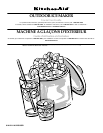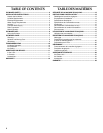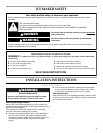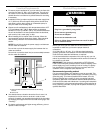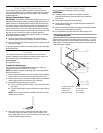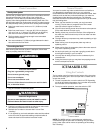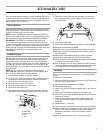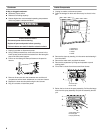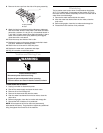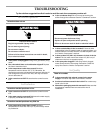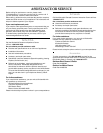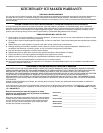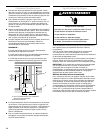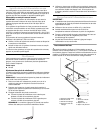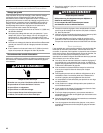
6
Drain Connection
Gravity drain system
Connect the ice maker drain to your drain in accordance with the
International Plumbing Code and any local codes and
ordinances. The ice maker is provided with a gravity drain
system, follow these guidelines when installing drain lines. This
will help keep water from flowing back into the ice maker storage
bin and potentially flowing onto the floor causing water damage.
■ Drain lines must have a minimum of ⁵⁄₈" (15.88 mm) inside
diameter.
■ Drain lines must have a 1" drop per 48" (2.54 cm drop per
122 cm) of run or ¹⁄₄" drop per 12" (6.35 mm per 30.48 cm)
and must not have low points where water can settle.
■ The floor drains must be large enough to accommodate
drainage from all drains.
■ You must maintain a 2" (5.08 cm) air gap between the drain
tube outlet and the floor drain.
Connecting the Drain
After ensuring that the drain system is adequate, follow these
steps to properly place the ice maker:
1. Plug in ice maker or reconnect power.
2. Push the ice maker into position so that the ice maker drain
tube outlet is positioned over the floor drain.
3. Recheck the ice maker to be sure that it is level. See
“Leveling.”
4. If it is required by your local sanitation code, seal the cabinet
to the floor with an approved caulking compound after all
water and electrical connections have been made.
Normal Sounds
Your new ice maker may make sounds that are not familiar to
you. Because the sounds are new to you, you might be
concerned about them. Most of the new sounds are normal. Hard
surfaces, such as the floor, walls and cabinets, can make the
sounds seem louder than they actually are. The following
describes the kinds of sounds that might be new to you and what
may be making them.
■ When you first start the ice maker, you may hear water
running. The ice maker is programmed to fill the water
reservoir before it begins to make ice.
■ You will hear a buzzing sound when the water valve opens to
fill the water reservoir for each cycle.
■ Rattling noises may come from the flow of the refrigerant or
the water line. Items stored on top of the ice maker can also
make noises.
■ The high-efficiency compressor may make a pulsating or high
pitched sound.
■ Water running over the evaporator plate may make a
splashing sound.
■ Water running from the evaporator plate to the water reservoir
may make a splashing sound.
■ As each cycle ends, you may hear a gurgling sound due to
the refrigerant flowing in your ice maker.
■ You may hear air being forced over the condenser by the
condenser fan.
■ During the harvest cycle you may hear low popping sounds
as the ice drops into the bin.
ICE MAKER USE
Using the Controls
The ice maker control is located on the bottom of the ice maker
just above the base grille. You must open the ice maker door to
access the control.
1. To start ice production, move the switch to ICE. Depending
on the air and water temperature, the ice maker will produce
the first batch of ice in less than 1 hour.
2. To stop ice maker operation, move the switch to OFF.
NOTE: The WASH setting is used whenever solutions are
circulated through the ice maker for cleaning. Only the water
pump, water valve and fan motor are operating at this setting.
See “Cleaning.”
Electrical Shock Hazard
Plug into a grounded 3 prong outlet.
Do not remove ground prong.
Do not use an adapter.
Do not use an extension cord.
Failure to follow these instructions can result in death,
fire, or electrical shock.
WARNING
WARNING
Excessive Weight Hazard
Use two or more people to move and install ice maker.
Failure to do so can result in back or other injury.
A.Control switch
OFF
A



